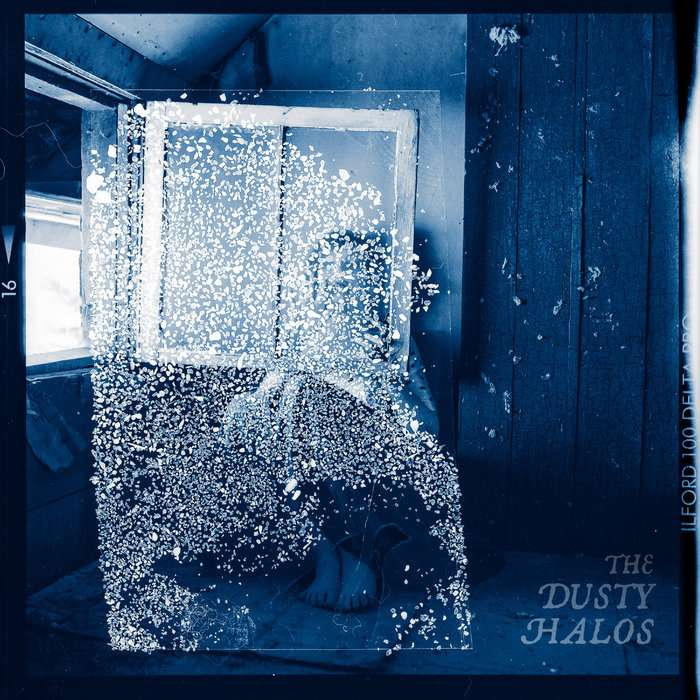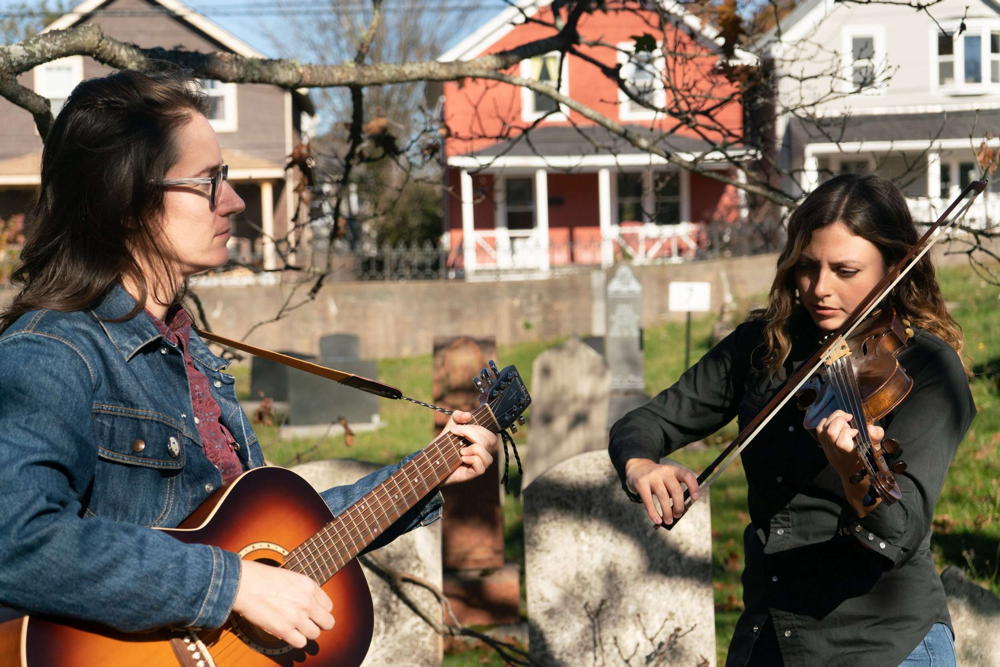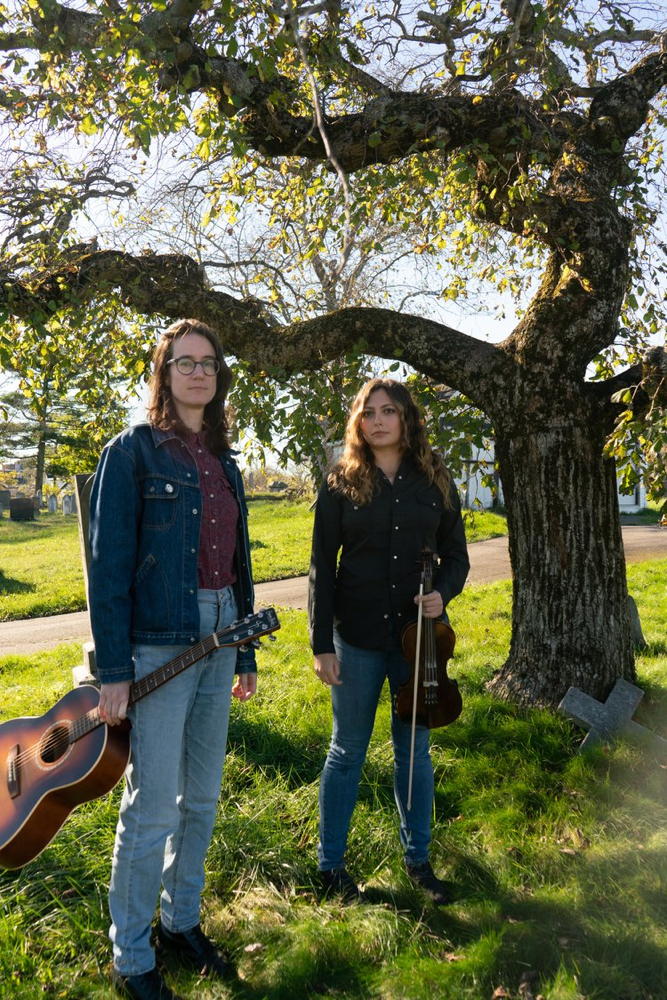
The Dusty Halos’ self-titled debut album is a testament to the quiet power of earnest music.
Rebecca Fairless and Katharine Harrison started their folk duo in 2022, sharing a love for choral singing, Townes Van Zandt, and sad old-timer music.
A reserved instrumentation (but far from shy) and Fairless’ poignant lyrics create a sense of being privy to private reflections on alienation, loneliness and longing. Staying true to the spirit of folk and bluegrass music, the delivery of these difficult themes makes you feel comforted, rather than like ending it all.
There is great chemistry between the protagonists in the musical arrangements: the two vocalists and their guitar and fiddle. Anyone who has had the pleasure of attending one of The Dusty Halos’ many live performances, in cozy venues across Halifax, will appreciate that their heartfelt, acoustic spirit carries across into the digital world. Lighting and Thunder, with its confident, opening bars, and Harrison’s haunting violin especially, stay true to what makes their live performances stand out.
However, Come Around and Fall take full advantage of the added possibilities of a recording studio. Kurtis McAllister’s sparse but powerful piano embellishments in Come Around punctuate vocals that are characteristically gentle in tone and crisp in articulation. There is a solid case for it being the strongest track on the album.
Fairless says, “Everything he did, I didn’t instruct him to do it. I just think he was the right person to work with us because we are kind of on the same wavelength when it comes to certain things.”
Fall reprises the intro with percussive elements and a complexity of composition that would be impossible for an acoustic two-piece to recreate at a live performance in a small café. The choral-sounding backing vocals on this song are a credit to the introspective, almost whispered quality of singing that makes the album's overall intimacy.
Acoustic guitar intros and instrumentals that serve the ebb and flow of vocals are hallmarks of this work. Fall and I Can Hear the Changes bring opposing levels of energy to the second half, closing with a curiously uplifting lilt. An upbeat Fairless cheerfully rings out her five polished songs, singing “There’s no place in this world for me.” Nonetheless, this self-titled album earns its place in the coveted real estate of Halifax’s music scene.
The Dusty Halos recently made lyric zines at RadStorm, available on their Bandcamp and at shows. They are currently finalizing CD’s. You can catch their album release show on December 9 at Good Robot’s ‘Mouse Trap’ room. Fairless has also recently done a live recording and interview on The Friendly Heckler podcast, you can check out the podcast on Spotify or Apple podcasts.
Background
Rebecca is a music therapist, pianist, singer, and songwriter from Alberta. She's an organist for the monthly Queer Spirit Church, which takes place on the first Wednesday evening of every month at the First Baptist Church Halifax on Oxford Street. This event is managed by Tamsin Robson and Reverend Arla Johnson and is also organist at St. Margaret of Scotland Church in Halifax's north end.
Katherine is a nurse, fiddle player, and singer with a music degree. She's experienced in choral singing and church choirs, including advanced choral and harmony singing.
The Dusty Halos name is a reference to a song by Jolie Holland.
Influences
Rebecca Fairless finds great inspiration in American indie-folk musician Sufjan Stevens. "I used to listen to his songs and play the banjo when I was younger. It was a connection to something that was both Christian and queer because up until then, I thought the two could not coexist. Lo and behold, they can."
Earlier this year, Stevens publicly came out and dedicated his new album ‘Javelin’ to his former partner Evan Richardson, who had passed away in April.

The duo also covered the song 'To Be Alone With You' by Stevens in a previous show. "That's the one where it's very much like: 'Is this song about Jesus or a gay lover?'" Rebecca said. In addition to Stevens, Rebecca Fairless cites other influences such as Gillian Welch, Jolie Harlow, The Be Good Tanyas, and Timbre Timber for a darker sound.
How does The Dusty Halos fit into the broader indie-folk music landscape?
"The Dusty Halos' sound borrows heavily from traditional folk styles and blues music, in terms of form and the way I play guitar in the fingerpicking style".
"I guess when I write a song, I like to make it both simultaneously sound old and universal but also personal, and also relevant, I guess, to something that might be feeling in the current day, so that becomes one of the interesting challenges of songwriting."
While The Dusty Halos' music is not particularly progressive or reinventing genres, they also don't stick to certain tropes. According to Rebecca, "When I write a song, I let it become what it becomes; it's an intuitive process.”
What was your songwriting process?
“It’s never one before the other or if it is then I can just go back and radically change it. Also, it's very long, sometimes months. Sometimes if I’ve written a song that I’m not that satisfied with I later go back and cannibalize it to a certain degree, I take parts of it and make them part of a completely new song,” she said.
“There's a reason this is my first album and there's only five songs, but I’m ok with that. That's just what works for me.” She added, “I have a capacity to be a perfectionist and sometimes I have to push through things faster just to not get stuck in that.”
“We could’ve spent more time on the album but it would've lost a certain rawness or spontaneity.”
For the song "Fall", she revealed that the song was written years ago during a week-long workshop for festival artists in Calgary. The songwriting workshop was with David Francey and participants were sent out to downtown Calgary to write lyrics inspired by what they saw. The idea for "Fall" came from Rebecca seeing a place getting demolished. She said, “Demolition is rife for metaphorical interpretations”.

“I definitely write about myself and sometimes about very specific things, but I don’t necessarily make it super explicit”, she explains.
She reflects, “A lot of it is stuff that goes back to my childhood, stuff that I’ve been grappling with for a long time and feels unresolved.”
“For example, in Fall, I wrote the chorus - it's a very simple chorus. I wrote that over 10 years ago and I was never able to do more with the song. I then discovered it and then I realized that it dealt with something that hadn’t actually happened yet”, she adds with laughter. “It was metaphorical. And then something happened later in my life that kind of made the words literally true, and I was very surprised to realize that. So I’ve realized that I’ve written songs whose meaning sometimes, years later, become clear.”
Reflecting on the music itself, Rebecca notes, “With music sometimes you don’t know, you can’t put your finger on the literal meaning, but there's an intuition that's there, and I've learned to trust that intuition.”
What about Kurtis McAllister and the recording process?
When it comes to producing great music, having the right person behind the scenes can make all the difference. And for The Dusty Halos, that person was none other than Kurtis McAllister.
And, the album art?
The album art concept of this project revolves around the theme of ghost imagery and the haunting nature of real ghosts or memories.
"We like to jokingly use ghost imagery. There's an element of being haunted by real ghosts or memories. Something old and unresolved lurking in the shadows but not necessarily sinister - just mysterious and open to discovery and connection", Rebecca explained.
Natalie Goulet did the album artwork, while Meg Yoshida played a role in the design. Natalie has a non-standard approach to photography, using expired film and various techniques to produce images with unique qualities. The album cover photograph was made using a double exposure technique and salt without any digital manipulation.
The choice of elements, such as the house, the window, and the wooden wall in the photograph, subtly aligns with tropes commonly associated with folk and country music, offering a visual cue about the album's musical identity.
The album's emotional resonance is enhanced by the predominant use of blue in the artwork. This colour adds depth to the mysterious and open theme, contributing to the overall visual experience.

